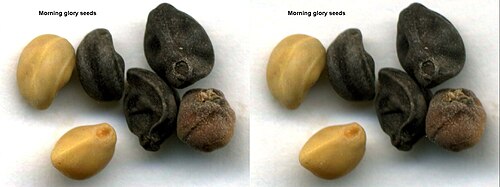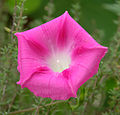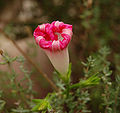Morning glory
This article needs additional citations for verification. (September 2015) |


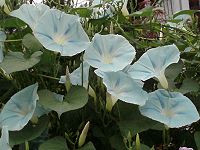

Morning glory (also written as morning-glory[1]) is the common name for over 1,000 species of flowering plants in the family Convolvulaceae, whose current taxonomy and systematics are in flux. Morning glory species belong to many genera, some of which are:
- Argyreia
- Astripomoea
- Calystegia
- Convolvulus
- Ipomoea (the largest genus)
- Lepistemon
- Merremia
- Operculina
- Rivea
- Stictocardia
As the name suggests, most morning glory flowers unfurl into full bloom in the early morning. The flowers usually start to fade a few hours before the corolla begins to display visible curling. They prefer full solar exposure throughout the day, and mesic soils. Some morning glories, such as Ipomoea muricata, Ipomoea alba, and Ipomoea macrorhiza, are night-blooming flowers.
History
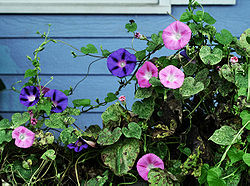
Ancient
Invasive species
In some places, such as Australian bushland, some species of morning glories develop thick roots and tend to grow in dense thickets. They can quickly spread by way of long, creeping stems. By crowding out, blanketing, and smothering other plants, morning glory has turned into a serious invasive weed problem.[4]
In parts of the US, species such as Calystegia sepium (hedge bindweed), Ipomoea purpurea (common morning glory) and Ipomoea indica (blue morning glory) have shown to be invasive. In fact, as of 2021, most non-native species of Ipomoea are currently illegal to cultivate, possess, and sell in the U.S. state of Arizona, and before 4 January 2020, this ban applied to native species, too. This is because some species of Convolvulaceae (like Convolvulus arvensis and Ipomoea × leucantha) have been known to cause problems in crops, especially in cotton fields.[5][6] Ipomoea aquatica is a federal noxious weed, though some states, like Texas, have acknowledged its status as a vegetable and allow it to be grown.[7][8]
Cultivation
In cultivation, most are treated as
Because of their fast growth, twining habit, attractive flowers, and tolerance for poor, dry soils, some morning glories are excellent vines for creating summer shade on building walls when trellised, thus keeping the building cooler and reducing heating and cooling costs.
Popular varieties in contemporary western cultivation include
Many morning glories self-seed in the garden. They have a hard seed coat, which delays germination until late spring. Germination may be improved by soaking in warm water.[9]
Morning glory has been a favorite flower in
Culinary uses
| Stereo image | |||
|---|---|---|---|
| |||
| |||
| |||
| |||
| Morning glory seeds, mixed colors | |||
The genus Ipomoea also contains the
Chemistry and ethnobotany
The
Gallery
-
Morning glory (Ipomoea cairica)
-
Blue morning glory (Ipomoea hederacea)
-
Blue and purple morning glory (Ipomoea purpurea)
-
A fully open pink morning glory (Ipomoea carnea)
-
Side view of a partially curled Ipomoea purpurea in early afternoon
-
The top of partially curled Ipomoea purpurea in early afternoon
-
The leaves of common morning glory (Ipomoea purpurea)
-
Opening blue morning glory (Ipomoea indica)
-
Close-up of a blue morning glory flower (Ipomoea indica)
-
Close-up of a hedge bindweed flower (Calystegia sepium)
-
Climbing morning glory vine (Ipomoea purpurea)
-
Blue morning glory flower (Ipomoea indica)
References
- ^ BSBI List 2007 (xls). Botanical Society of Britain and Ireland. Archived from the original (xls) on 2015-06-26. Retrieved 2014-10-17.
- PMID 10373117. Retrieved 25 October 2021 – via science.org (Atypon).
- ^ "Rubber processed in ancient Mesoamerica, MIT researchers find". News.mit.edu. Retrieved 25 October 2021.
- ^ "Archived copy" (PDF). Archived from the original (PDF) on 2017-03-29. Retrieved 2020-03-24.
{{cite web}}: CS1 maint: archived copy as title (link) - ^ "Why We Can't Sell Native Morning Glories". Desertsurvivors.org. Retrieved 2021-09-03.
- ^ "The Curious Case of Arizona's Morning Glories (Ipomoea spp.)" (PDF).
- ^ a b "Texas Register - The Portal to Texas History". The Portal to Texas History.
- ^ a b "USDA weed factsheet" (PDF). Aphis.usda.gov. Retrieved 25 October 2021.
- ^ "How to Grow Morning Glories". wikiHow. Retrieved 2021-10-03.
- ^ a b c d "The Japan Magazine A Representative Monthly of Things Japanese vol 7" S. Murayama, Japan magazine Company 1916, p175
- ^ くらしの植物苑特別企画「伝統の朝顔」 National Museum of Japanese History.
- ^ Vargas, Theresa (2006-05-03). "A '60s Buzz Recycled". The Washington Post. Retrieved 2010-05-13.
- ISBN 0-8493-1187-X.
Further reading
- Everitt, J.H.; Lonard, R.L.; Little, C.R. (2007). Weeds in South Texas and Northern Mexico. Lubbock: Texas Tech University Press. ISBN 978-0-89672-614-7.
- Furst, Peter (1990). Flesh of the Gods. ISBN 978-0-88133-477-7.
- Schultes, Richard Evans (1976). Hallucinogenic Plants. Elmer W. Smith, illustrator. New York: Golden Press. ISBN 0-307-24362-1.
External links
 Texts on Wikisource:
Texts on Wikisource:
- "Morning Glory". Collier's New Encyclopedia. 1921.
- "Morning Glory". The New Student's Reference Work. 1914.
- Erowid Morning Glory Vault
- Morning Glory Flowers is a book from 1854 (in English and Japanese)









